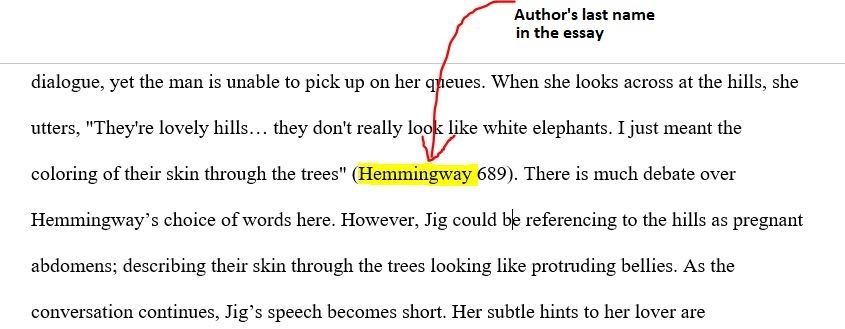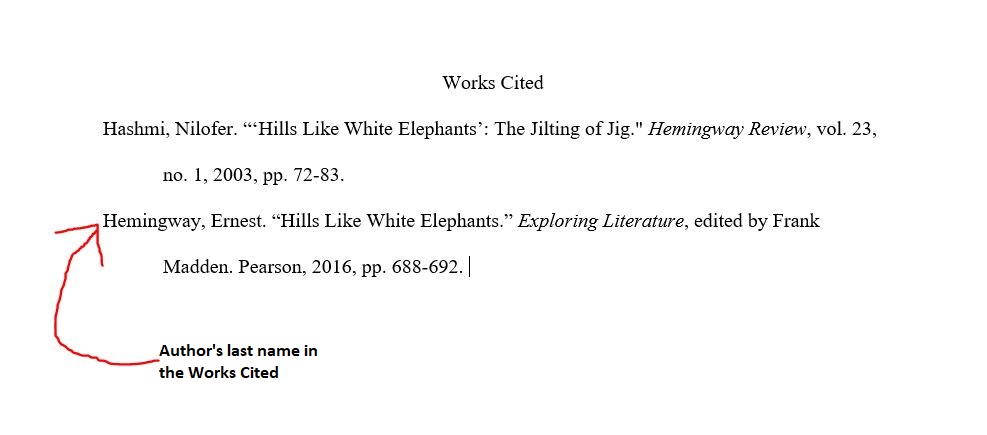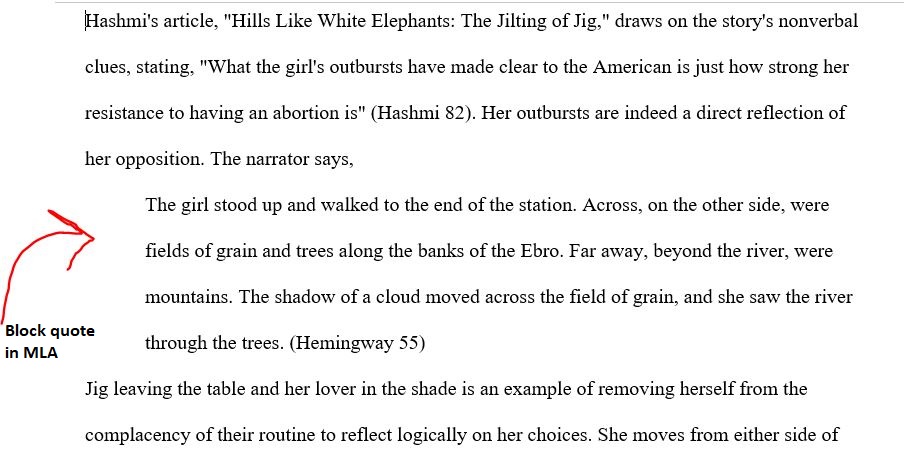26
Dr. Sandi Van Lieu and Dr. Karen Palmer
In-Text Citations
The first step is to correctly cite each source you will use in your paper in your list of sources. Then, when you include a quote or a reference from a source, be sure to correctly cite the source in an in-text citation.
- Introduce your quote with a signal phrase (don’t just copy and paste something from your source!).
- Make sure the quote is in quotation marks.
- Properly cite the quote with an in-text citation. Before the end mark, in parenthesis, type the first word/words of the source listing (this will match your Works Cited page).
- Wrap up your quote by reiterating for readers what point the quote makes (analysis/evaluation).
The in-text citation must match the first word in the list of sources. So, if your source has an author, you would put the author’s name in the in-text citation and also at the end in the works cited. See the following example from a paper formatted using MLA documentation style:


Formatting In-Text References
Signal Phrases (also known as transitions)
When you use others’ ideas, you have a variety of options for integrating these sources into your text. The main requirement is that you make it clear within your in-text reference that the information is not yours and that you clearly indicate where you got the idea. The following box shows some alternate phrases for signaling that the ideas you are using belong to another writer. Using a variety of wording makes writing more interesting.
Note: MLA, use present tense in signal phrases (for example: states, argues, notes).
Phrases That Signal an Idea Belongs to Another Writer (MLA does not include a year):
- According to Starr, “Quote”
- Acknowledging that…
- Starr states…
- As Starr notes…
- Starr reports…
- In the words of Starr…
- It is clear, according to Starr, that…
- Starr argues that…
- Starr disagrees when she says…
- Starr emphasizes the importance of…
- Starr suggests…
- Starr observes in a 2010 study that…
- Technology specialist, Linda Starr, claims that…
- …indicates Starr.
- …writes Starr.
Integrating Sources (Using Direct Quotations)
The tables below shows some actual examples of integrating sources within the guidelines of MLA. Note how the cited details are woven in with the author’s ideas.
| MLA | |
|---|---|
| Explanation | Short Quotations: Place within quotation marks and follow with page number in parentheses (#). Include the author’s name either in a signal phrase before the quotation or at the end (name #) |
| Long Quotations (more than four lines): Place in an inset block of text without quotations. Include the author’s name either in a signal phrase before the quotation or at the end (name #). | |
| Example #1 Short Quotation | According to Fullan, “Educational change depends on what teachers do and think—it’s as simple and complex as that” (107). |
| Example #2 Short Quotation | According to one author, “Educational change depends on what teachers do and think—it’s as simple and complex as that” (Fullan 107). |
Long quotations
A quotation longer than four lines should be in block form, like this:

Examples 1:
Author’s Name Not in the Sentence:
If you don’t say the author’s name in the sentence, then the author’s name needs to go in the in-text citation. Remember that direct quotes require page numbers.
Example:
The author writes, “Not mine, not mine, not mine, but Mrs. Price is already turning to page thirty-two, and math problem number four” (Cisneros 1).
Author’s Name in the Sentence:
If you do say the author’s name in the sentence (usually in the transition or signal phrase), then the author’s name doesn’t need to go in the in-text citation. Remember that direct quotes require page numbers unless it’s a website.
Example:
Cisneros writes, “Not mine, not mine, not mine, but Mrs. Price is already turning to page thirty-two, and math problem number four” (1).
Integrating Sources (Summarized or Paraphrased Ideas):
| MLA | |||
|---|---|---|---|
| Explanation | Author’s name: Either within a signal phrase or in parentheses before the period at the end of the sentence. | ||
| Page number: Either alone before the period at the end of the sentence or after the name within the parentheses before the period at the end of the sentence (name #). | |||
| Example #1 | Many school staffs discuss integrating technology without making significant progress in that direction. Starr indicates that teachers’ lack of personal understanding of technology can cause road blocks to integrating technology into classrooms (1). | ||
| Example #2 | Many school staffs discuss integrating technology without making significant progress in that direction. Teachers’ lack of personal understanding of technology can cause roadblocks to integrating technology into classrooms (Starr 1). |
Two Authors:
| MLA | |||
|---|---|---|---|
| Example #1 | Merriman and Nicoletti suggest that US K–12 education must take on a structure that is globally acceptable (9). | ||
| Example #2 | US K–12 education must take on a structure that is globally acceptable (Merriman and Nicoletti 9). |
Multiple Authors:
| MLA | ||
|---|---|---|
| Explanation | Two authors: Treat in same manner as two authors: (name and name). | |
| Three or more authors: Use the first author’s last name plus “et al.” (name et al.). | ||
| Example #1 | Borsheim et al. suggest that teachers do not have to give up traditional curricula in order to integrate technology (87). | |
| Example #2 | Some have argued that technology has become part of education without a great deal of effort from teachers (Borsheim et al. 87). |
Personal Communication:
| MLA | ||
|---|---|---|
| Example #1 | Stanforth indicates she had been using a computer board in her classroom for three years and could not imagine giving it up. | |
| Example #2 | Many teachers are angry that they are being pushed to include technology because they like the way their classrooms work without it (Kennedy). |
Additional Notes:
If an article/source is viewed in PDF, you can use the paragraph number or the page number, depending on what’s easier. For example, if the PDF has 100 paragraphs, then it might be difficult to count them all, but if the PDF only has two pages, yet is a short story with many lines, then it might be easier to count the paragraphs.
Example:
(Hemingway, par. 1)
(Hemingway 3)
In MLA, you DO NOT us a comma before the page number, but you DO use a comma if you are using a paragraph number rather than a page number.
For page number, you simply put the number in the citation, like this:
(Cisneros 1).
For paragraph number, you need the “par.” like this:
(Cisneros, par. 2).
Examples with No Authors:
It is recommended that you always choose sources that have an author so that you can determine the author’s credibility; however, if your instructor allows you to use sources (usually websites) with no authors, then follow the formatting rules below.
If a source doesn’t have an author, use the title of the source (such as the title of the web page), or the name of the organization.
MLA Summary or Paraphrase:
A dry desert is different from a coastal desert in several ways (“Deserts”).
According to the Center for Disease Control, the wearing a masks helps to prevent one from getting Covid-19.
MLA Direct Quote (Note: page numbers are no longer required for websites with no author):
A dry desert “has specific characteristics that differentiate” it from a coastal desert (“Deserts”).
According to Center for Disease Control, the best way to “prevent transmission of Covid-19 is to wear a mask.”
According to one organization, the best way to “prevent transmission of Covid-19 is to wear a mask” (Center for Disease Control).
Video Overview
MLA Citation
Exercise 1
1. Go through your essay rough draft and make sure that each in-text citation directly matches the Works Cited or Reference page. For example, if my in-text citation says this–
(Smith 54)
–then “Smith” must be the first word in my Works Cited:
Smith, John. “Creating a website….”
Especially watch that your websites match as well. For example, if my in-text citation says this–
(Center for Disease Control).
–then “Center for Disease Control” must be the first word in my Works Cited:
Center for Disease Control. “Staying Safe….”
The same goes for websites without authors. My in-text citation:
(“Deserts are Alive”).
My corresponding Works Cited:
“Deserts are Alive.” Deserts Design….
Exercise 2
1. Go through your essay and check all of your in-text citations that they are in the correct format.
Additional Resource:
The OWL at Purdue is one of the best websites you can use for how to do proper in-text citations. There are several rules about sources such as quoting a source within a source, citing multiple authors, and more. Because of this, it’s important you use this website to determine how to probably use the in-text citations. Also, check the appendix of this textbook for the MLA/APA guides.
Attribution
- Content created by Dr. Sandi Van Lieu and Dr. Karen Palmer and licensed CC BY NC SA.
